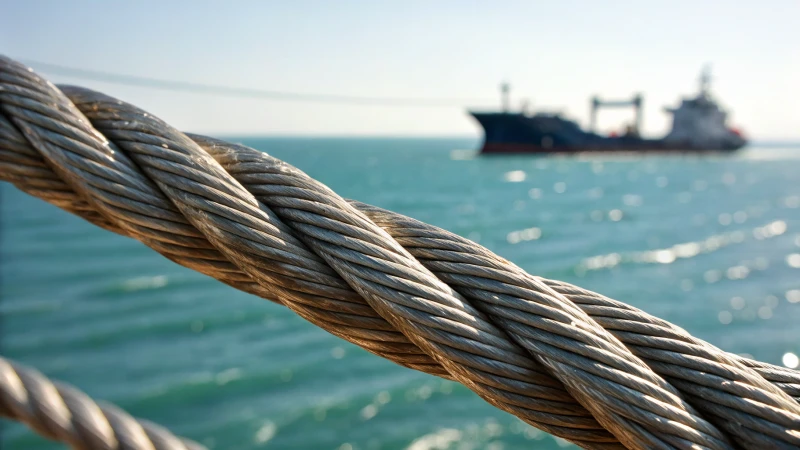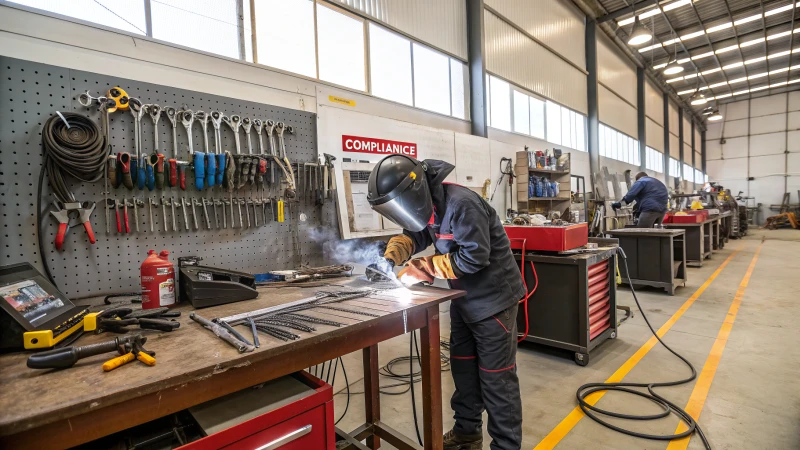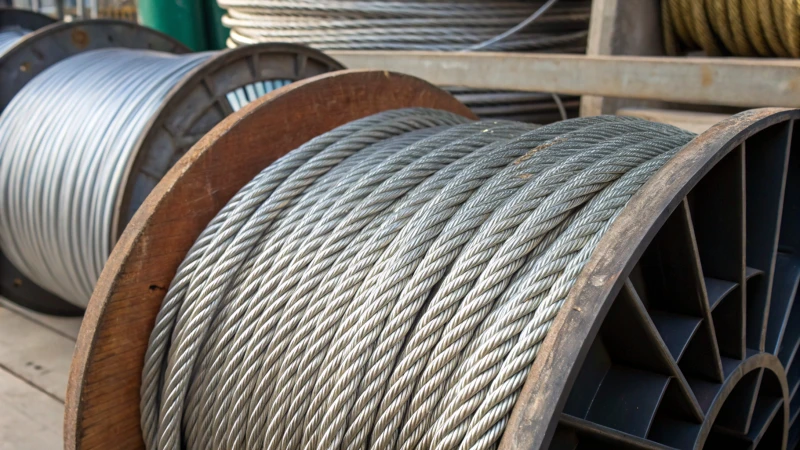
Navigating the high seas is no small feat, and choosing the right steel wire rope can make all the difference in ensuring safety and longevity.
For offshore and marine use, steel wire ropes must adhere to ISO 17657 and EN 12385-4 standards. These benchmarks guarantee the ropes' ability to withstand harsh conditions, thanks to rigorous testing and precise material specifications.
I remember when I first had to source steel wire ropes for a project. It was daunting, with so many factors to consider beyond just meeting the standards like ISO 17657 and EN 12385-4. The environment they would endure—salty air, UV exposure, and heavy loads—required ropes that not only met these benchmarks but also had superior material composition and resilience. Diving deeper into this topic, you’ll find that understanding how these elements interplay can significantly impact the choice of rope, ensuring both performance and safety over the years. Whether it's for a construction crane or a marine vessel, knowing what to look for can save you from future headaches and ensure you're investing in ropes that last.
ISO 17657 is a standard for steel wire ropes.True
ISO 17657 specifies testing methods for steel wire ropes used offshore.
EN 12385-4 applies to freshwater environments only.False
EN 12385-4 is designed for corrosive marine environments, not limited to freshwater.
Why Are ISO 17657 and EN 12385-4 Standards Critical?
Ever wondered why ISO 17657 and EN 12385-4 standards are the unsung heroes of industrial safety?
ISO 17657 ensures the precise calibration and testing of resistance welding equipment, guaranteeing strong welds. Meanwhile, EN 12385-4 sets safety benchmarks for steel wire ropes in lifting, focusing on durability and safety.

Understanding ISO 17657: Calibration and Testing
Imagine standing on the factory floor, the hum of machinery around you, knowing every weld holds because ISO 17657 has your back. This standard is my go-to when ensuring that the resistance welding1 equipment I rely on is perfectly calibrated. The beauty of ISO 17657 is in its detailed guidelines that help me set up welding machines to perform at their best. It’s like having a manual that walks me through testing procedures to ensure that each weld is not just strong, but reliable.
Key Components of ISO 17657
- Calibration Procedures: I use these guidelines to fine-tune welding machines, optimizing performance.
- Testing Methods: Standards that I trust for verifying the functionality and accuracy of equipment.
- Documentation: It’s crucial for me to keep meticulous records of calibrations and tests, safeguarding compliance with safety norms.
With ISO 17657, I feel confident that I’m reducing manufacturing defects2 and aligning with international safety standards.
Exploring EN 12385-4: Steel Wire Rope Safety
In industries like construction or marine, where steel wire ropes are lifelines, EN 12385-4 becomes my playbook. Picture this: you're on-site, and you know the ropes you're using are crafted following stringent safety guidelines. This standard reassures me about the production, use, and maintenance of steel wire ropes. It's all about choosing the right materials and ensuring these ropes can withstand the toughest conditions.
Core Elements of EN 12385-4
| Aspect | Description |
|---|---|
| Material Selection | Criteria for choosing corrosion-resistant materials like epoxy. |
| Performance Testing | Methods like salt-spray testing to evaluate longevity. |
| Safety Inspections | Regular checks to ensure ropes maintain integrity over time. |
By implementing EN 12385-4, I’ve seen firsthand how industries enjoy improved safety outcomes and extended equipment performance3, ultimately saving on operational risks and costs over time.
ISO 17657 ensures precise calibration of welding equipment.True
ISO 17657 provides guidelines for calibrating resistance welding equipment.
EN 12385-4 does not cover steel wire rope safety.False
EN 12385-4 outlines safety guidelines for steel wire ropes.
How Do Material Choices Affect Steel Wire Rope Performance?
Ever wondered how a seemingly simple choice can make or break your project? Picking the right material for steel wire ropes is one of those pivotal decisions.
Choosing the right material for steel wire ropes significantly impacts their performance, affecting factors like corrosion resistance, tensile strength, and flexibility. Stainless steel offers superior corrosion resistance, while galvanized steel provides a more economical durability option.

Material Types and Their Properties
I remember standing in front of a warehouse full of materials, feeling a bit overwhelmed. There were so many options, and each choice came with its own set of pros and cons. Let me break it down for you, just as I did for myself back then.
-
Stainless Steel: This is your go-to if you're dealing with salty sea breezes or corrosive environments. I once had a project offshore where the salty air was relentless. Stainless steel was our savior, standing strong against the elements. It's pricier, but for marine or harsh conditions, it's worth every penny.
- Meets stringent standards4 like ISO 17657 and EN 12385-4.
-
Galvanized Steel: If you're juggling cost and durability, this might be your best friend. Imagine working on a construction site where budgets are tight but you still need reliability. The zinc coating on galvanized steel gives decent rust protection without breaking the bank.
-
Ungalvanized Steel: Think of this as the budget-friendly option. It's like choosing an economy car for city driving; perfect for indoor use where weather isn't a concern. Just remember, it'll need more care if exposed to the elements.
| Material | Corrosion Resistance | Cost | Application Areas |
|---|---|---|---|
| Stainless Steel | High | High | Marine, Offshore |
| Galvanized Steel | Moderate | Moderate | Construction |
| Ungalvanized | Low | Low | Indoor Industrial |
Coating and Its Impact on Durability
Back in the day, I underestimated the power of coatings until I learned the hard way. Coatings like epoxy or polyurethane aren't just fancy extras—they're game-changers, extending rope life by shielding them from harsh environments.
-
Epoxy Coatings: Known for their robustness against abrasions—ideal for high-stress scenarios like mining.
- Tested rigorously using methods like salt-spray testing5.
-
Polyurethane Coatings: On the other hand, is like that adaptable friend who's ready for anything. It offers flexibility and strong resistance to chemicals—perfect if you're in an environment with chemical exposure risks.
Both types of coatings undergo rigorous testing to ensure they can handle whatever comes their way.
Importance of Material Standards
Let me tell you, there's nothing worse than assuming something will work and then watching it fail because it didn't meet industry standards. Standards like ISO 176576 ensure that your materials can withstand the specific challenges of their environment. It's like having a trusty guidebook when you're navigating unfamiliar terrain.
In summary, picking the right material isn't just about what sounds good on paper; it's about understanding the environment and application needs to make informed choices. Each material brings something unique to the table, just like different team members with distinct strengths. Choose wisely!
Stainless steel is cost-effective for marine use.False
Stainless steel offers high corrosion resistance but is expensive.
Galvanized steel is suitable for mining operations.True
Galvanized steel balances cost and corrosion resistance, ideal for mining.
What testing methods ensure durability in marine environments?
Have you ever wondered how materials stand the test of time amidst the relentless waves and salty air of marine environments?
To ensure durability in marine environments, I rely on rigorous testing methods like salt-spray tests, UV resistance checks, and tensile strength evaluations. These tests mimic the harsh sea conditions, ensuring that materials such as steel wire ropes can endure corrosion and wear over long periods.

Salt-Spray Testing
Whenever I think about the ocean's unyielding nature, I remember the first time I saw a salt-spray test in action. Imagine placing a specimen inside a chamber that mimics the salty sea fog—it's almost like bringing a bit of the ocean indoors. We expose the material to this saline mist at carefully controlled temperatures and humidity levels. The process can last anywhere from a quick 24 hours to a painstaking 1,000 hours, depending on how robust we need the material to be.
-
How It Works:
- Picture a piece of steel wire rope standing firm as it gets engulfed in a salty haze.
- The chamber is kept at specific temperatures to replicate marine conditions.
-
Applications:
- This test is crucial for materials like steel wire ropes, helping us predict their lifespan in corrosive environments.
Learn more about salt-spray testing7.
UV Resistance Tests
Sunlight is one of those things we love until it starts to wear things down. That's why UV resistance tests are essential. I remember the first time I saw how quickly a material could degrade under artificial UV light—it was eye-opening! These tests help us see how materials will hold up over years of exposure to sunlight, but we do it in a much shorter time frame.
-
Testing Process:
- Samples are placed under powerful UV lights.
- This setup accelerates what would naturally occur over years.
-
Importance:
- This test ensures that marine equipment doesn't lose its integrity over its expected lifespan.
Explore UV resistance testing8.
Tensile Strength Evaluation
Tensile strength tests are like watching a tug-of-war match—except with materials. You learn so much about how much force something can withstand before it finally gives way. I've always found it fascinating to see just how strong these ropes are.
-
Procedure:
- The material is pulled with increasing force until it breaks.
- We record the maximum force it withstands as its tensile strength.
-
Benefits:
- The data helps us refine material formulations to boost their durability under harsh marine conditions.
Find out more about tensile strength tests9.
Table of Common Tests and Their Uses
| Test Type | Purpose | Material |
|---|---|---|
| Salt-Spray Testing | Assess corrosion resistance | Steel wire ropes |
| UV Resistance Tests | Evaluate long-term UV exposure effects | Coated marine equipment |
| Tensile Strength Evaluation | Measure load-bearing capacity | Heavy-duty marine ropes |
For a detailed overview of testing standards, check this resource10.
These testing methods give me confidence that the materials we use in marine applications won't let us down, providing both peace of mind and ensuring safety. After all, testing is not just about ticking boxes—it's about knowing that when the going gets tough, our materials will stand strong against the elements.
Salt-spray tests simulate marine conditions.True
Salt-spray tests use saline fog in controlled settings to mimic marine environments.
UV resistance tests are irrelevant for marine equipment.False
UV tests are crucial to ensure marine equipment withstands prolonged sunlight exposure.
How do you choose the right steel wire rope?
When I first needed to pick the right steel wire rope, I felt overwhelmed by choices. But diving into factors like strength and resistance helped me find just what I needed.
To choose the right steel wire rope, focus on load capacity, environmental conditions, and industry standards. By evaluating the rope's construction, material, and coating, you can ensure it aligns perfectly with your operational needs.

Understanding Steel Wire Rope Construction
Let me take you back to when I first learned about steel wire ropes. I remember standing in a warehouse, staring at rows of coiled ropes, each with its own unique twist. These ropes are like little communities of wires—each wire twisted into a strand, and then those strands twisted around a core. It's a bit like braiding hair, but much more complex and with serious implications for flexibility and strength.
Here are some common types I discovered:
| Construction Type | Characteristics |
|---|---|
| 6x19 | Flexible, suitable for cranes |
| 6x36 | Offers more flexibility, used in lifts |
| 19x7 | High fatigue resistance, ideal for winches |
Understanding the construction type11 is crucial in selecting the right rope for your specific application.
Material Considerations
When choosing materials, it's like picking the perfect outfit for the weather. Stainless steel ropes feel like the all-weather jacket I rely on during rainy days—great for corrosive environments12 like marine settings because they resist rust like a champ. Galvanized steel is more like a sturdy windbreaker—offering decent protection without breaking the bank.
Here's what I keep in mind:
- Stainless Steel: Perfect for corrosive environments
- Galvanized Steel: Cost-effective with moderate corrosion resistance
- Coated Ropes: Think of PVC or nylon coatings as an extra layer of protection
Environmental Factors
You know how you wouldn't wear sandals in the snow? Similarly, considering the environment where the rope will be used is vital. For offshore or marine environments, following standards like ISO 17657 is essential. Coatings such as epoxy or polyurethane can make your rope last longer in harsh conditions.
Testing methods such as salt-spray and UV resistance tests are my go-to checks to ensure longevity. This becomes crucial in tough conditions where reliability over long periods is a must.
Industry Standards and Certifications
It's reassuring to know that your wire rope meets relevant industry standards and certifications. This guarantees quality, safety, and performance:
- ISO 17657: Related to marine applications13
- EN 12385-4: Focused on safety and durability
Load Capacity and Safety Factors
Calculating load capacity is like packing your suitcase—overpacking can lead to disaster! You must understand the load you're lifting and choose a rope with the right safety margin. Safety factors typically range from 5:1 to 10:1 based on the application.
6x19 wire ropes are best for crane use.True
6x19 construction offers flexibility, making it suitable for cranes.
Stainless steel ropes are unsuitable for marine environments.False
Stainless steel offers excellent corrosion resistance, ideal for marine use.
Conclusion
Essential steel wire rope standards for offshore and marine use include ISO 17657 and EN 12385-4, ensuring durability, safety, and performance in harsh environments.
-
Discover detailed procedures for resistance welding calibration under ISO 17657. ↩
-
Learn how adhering to ISO 17657 reduces manufacturing defects effectively. ↩
-
Explore performance testing methods under EN 12385-4 for enhanced equipment safety. ↩
-
Understanding ISO 17657 can help ensure that your steel wire ropes meet necessary performance standards for specific applications. ↩
-
Discover more about effective coatings that enhance corrosion resistance in saltwater environments. ↩
-
Learn about ISO 17657 to ensure compliance with industry standards for steel wire ropes. ↩
-
Salt-spray testing simulates marine conditions to evaluate material durability against corrosion, ensuring longevity in harsh environments. ↩
-
UV resistance testing assesses material endurance against sunlight exposure, crucial for maintaining marine equipment integrity. ↩
-
Tensile strength evaluation measures the load capacity of materials, essential for ensuring durability in marine environments. ↩
-
This resource provides an overview of essential tests ensuring material durability in marine environments. ↩
-
Explore various steel wire rope constructions to understand their specific applications and benefits. ↩
-
Discover why stainless steel ropes are preferred for corrosive environments. ↩
-
Learn about marine standards to ensure compliance and performance in marine environments. ↩

